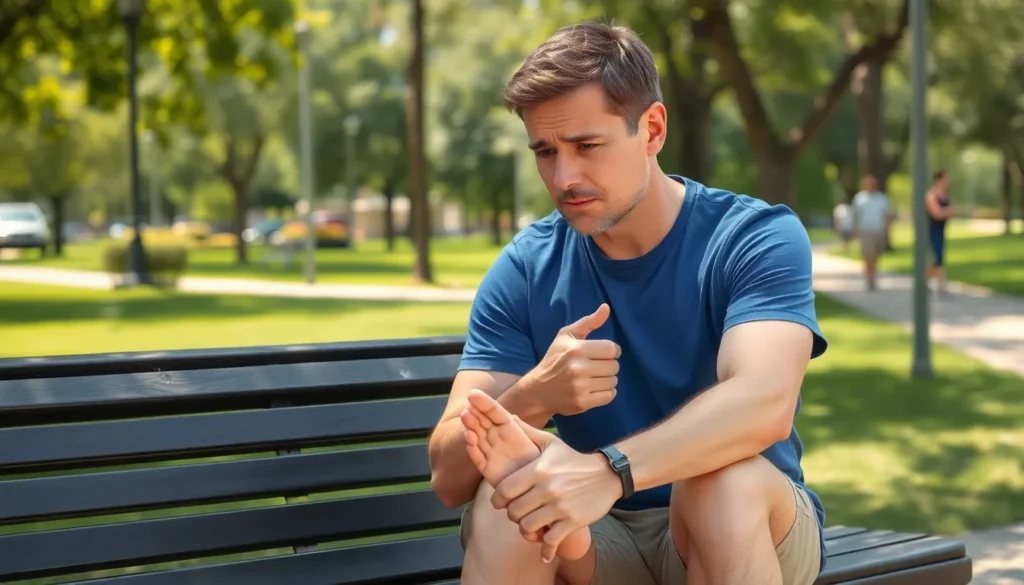Pavatalgia might sound like a fancy dish at a five-star restaurant, but it’s actually a condition that can leave many scratching their heads—and their feet. If you’ve been wondering how long you can live with this pesky foot pain, you’re not alone. It’s a question that many ask, hoping for answers that don’t involve a lifetime supply of orthopedic shoes or endless ice packs.
Understanding the duration and impact of pavatalgia is crucial for anyone dealing with this discomfort. While it might feel like a never-ending saga, the good news is that with the right knowledge and treatment, it doesn’t have to be. So, let’s dive into what pavatalgia really means and how you can manage it, giving you the freedom to kick off those shoes and live life to the fullest.
Table of Contents
ToggleUnderstanding Pavatalgia
Pavatalgia refers to persistent pain in the foot. This condition affects daily activities and overall quality of life.
Definition of Pavatalgia
Pavatalgia involves discomfort that usually originates from various foot structures. Conditions such as tendonitis, plantar fasciitis, or nerve compression can lead to this type of pain. Specific foot movements often exacerbate the discomfort, making it important to identify the underlying cause. Proper diagnosis helps in managing this condition effectively.
Symptoms and Causes
Symptoms of pavatalgia typically include localized pain, swelling, and stiffness. Discomfort often intensifies with activity or prolonged standing. Various factors contribute to its onset. Injury or overuse is a common cause, as well as the use of improper footwear. Additionally, conditions like arthritis or diabetes can increase vulnerability to foot pain, further complicating recovery. Understanding these causes assists in developing effective treatment strategies.
Factors Influencing Lifespan

Pavatalgia’s impact on lifespan can vary significantly based on several crucial factors. Understanding these influences is essential for effective management and improving quality of life.
Severity of Condition
Severity of pavatalgia plays a vital role in determining overall well-being. Mild cases often allow individuals to maintain daily activities without major disruptions. More severe cases, however, intensify pain, limit mobility, and may necessitate frequent medical interventions. Persistent pain can lead to complications, including mobility impairment or chronic health issues. Treatment effectiveness also hinges on severity, with tailored approaches required for more advanced conditions. Regular assessments help ensure appropriate interventions align with the current severity levels.
Underlying Health Factors
Underlying health factors significantly contribute to pavatalgia’s prognosis. Conditions such as diabetes, arthritis, or previous injuries complicate the management and increase symptom severity. Those with diabetes face risks of neuropathy, amplifying foot pain issues. Arthritis can exacerbate inflammation and stiffness, leading to further discomfort. Concurrent health issues require comprehensive treatment plans that address both pavatalgia and health conditions. Individuals with robust health may experience milder symptoms and better outcomes compared to those with multiple underlying issues. Understanding these connections is key to effective management strategies.
Treatment Options
Effective treatment options for pavatalgia can significantly enhance quality of life. Approaches often vary based on individual needs and specific symptoms.
Medical Treatments
Physical therapy offers tailored exercises that strengthen foot muscles and improve flexibility. Nonsteroidal anti-inflammatory drugs, or NSAIDs, help reduce pain and inflammation. Corticosteroid injections may provide relief for those experiencing severe discomfort. Custom orthotics assist in correcting foot mechanics, alleviating pressure on affected areas. In some cases, surgery becomes necessary, particularly for persistent pain linked to structural issues. Consulting healthcare professionals ensures a comprehensive understanding of available medical treatments based on personal conditions.
Lifestyle Changes
Incorporating low-impact activities, like swimming or cycling, minimizes stress on the feet. Regular stretching enhances flexibility and can prevent pain flare-ups. Wearing supportive footwear makes a significant difference, as improper shoes contribute to discomfort. Maintaining a healthy weight reduces pressure on the feet and can mitigate symptoms. Consider engaging in mindfulness practices to manage pain perception effectively. Adjusting daily routines to include regular breaks from standing supports mobility and lessens fatigue.
Long-Term Outlook
Pavatalgia can impact individuals differently over time. The prognosis varies based on severity, underlying conditions, and treatment responsiveness. Some patients experience symptom relief through consistent management, while others face chronic discomfort necessitating ongoing interventions.
Prognosis for Patients
Patients with mild pavatalgia often enjoy a good prognosis, as symptoms tend to improve with proper care. Severely affected individuals struggle more; persistent pain and mobility issues may arise without effective treatment. Factors such as reinforcing overall health significantly influence outcomes, while those with related conditions like diabetes often experience intensified symptoms. Regular consultations with healthcare providers support long-term management strategies that can enhance quality of life.
Managing Symptoms
Managing symptoms of pavatalgia involves a combination of medical and lifestyle approaches. Physical therapy serves as an effective option, promoting foot strength and flexibility. Medical professionals often recommend appropriate medications, including NSAIDs for pain relief and corticosteroids for inflammation. Patients benefit from wearing supportive shoes designed to mitigate discomfort while maintaining mobility. Regular engagement in low-impact exercises and stretching exercises can further reduce pain intensity. Incorporating these strategies into daily life fosters better coping mechanisms for individuals dealing with pavatalgia.
Living with pavatalgia can be challenging but understanding the condition is the first step toward effective management. The duration and severity of symptoms vary widely among individuals. While some may experience temporary discomfort that resolves with proper care others may face chronic pain requiring ongoing treatment.
Tailoring a management plan that includes medical interventions lifestyle changes and regular consultations with healthcare professionals is crucial. This comprehensive approach not only addresses the immediate symptoms but also enhances overall quality of life. By staying informed and proactive individuals can navigate the complexities of pavatalgia and find relief.






